High-Performance Photodetectors Based on the 2D SiAs/SnS2 Heterojunction
Abstract
:1. Introduction
2. Experimental Section
2.1. Synthesis of SiAs Crystal
2.2. Characterization
2.3. Transfer Methods
2.4. Device Fabrication and Measurements
3. Results and Discussion
3.1. Synthesis of SiAs Crystal
3.2. Basic Characterization of SiAs Crystal
3.3. Atomic-Level Morphology Characterization of SiAs Crystal
3.4. Low Wavenumber Raman Vibration Mode of SiAs Crystal
3.5. Photoelectric Correspondence of SiAs/SnS2 Heterojunction
3.6. Investigation of Photovoltaic Characteristics of p–n Junction
4. Conclusions
Supplementary Materials
Author Contributions
Funding
Institutional Review Board Statement
Informed Consent Statement
Data Availability Statement
Conflicts of Interest
References
- Liu, C.; Gao, Z.; Zeng, J.; Hou, Y.; Fang, F.; Li, Y.; Qiao, R.; Shen, L.; Lei, H.; Yang, W.; et al. Magnetic/Upconversion Fluorescent NaGdF4:Yb,Er Nanoparticle-Based Dual-Modal Molecular Probes for Imaging Tiny Tumors in Vivo. ACS Nano 2013, 7, 7227–7240. [Google Scholar] [CrossRef] [PubMed]
- Wang, Y.F.; Liu, G.Y.; Sun, L.D.; Xiao, J.W.; Zhou, J.C.; Yan, C.H. Nd3+-Sensitized Upconversion Nanophosphors: Efficient In Vivo Bioimaging Probes with Minimized Heating Effect. ACS Nano 2013, 7, 7200–7206. [Google Scholar] [CrossRef] [PubMed]
- Gibart, P.; Auzel, F.; Guillaume, J.; Zahraman, K. Below Band-Gap IR Response of Substrate-Free GaAs Solar Cells Using Two-Photon Up-Conversion. Jpn. J. Appl. Phys. 1996, 35, 4401–4402. [Google Scholar] [CrossRef]
- Chen, J.H.; Jang, C.; Xiao, S.; Ishigami, M.; Fuhrer, M.S. Intrinsic and extrinsic performance limits of graphene devices on SiO2. Nat. Nanotechnol. 2008, 3, 206–209. [Google Scholar] [CrossRef] [PubMed]
- Fontana, M.; Deppe, T.; Boyd, A.K.; Rinzan, M.; Liu, A.Y.; Paranjape, M.; Barbara, P. Electron-hole transport and photovoltaic effect in gated MoS2 Schottky junctions. Sci. Rep. 2013, 3, 1634. [Google Scholar] [CrossRef] [Green Version]
- Bai, S.; Niu, C.Y.; Yu, W.; Zhu, Z.; Cai, X.; Jia, Y. Strain Tunable Bandgap and High Carrier Mobility in SiAs and SiAs2 Monolayers from First-Principles Studies. Nanoscale Res. Lett. 2018, 13, 404. [Google Scholar] [CrossRef]
- Mortazavi, B.; Shahrokhi, M.; Cuniberti, G.; Zhuang, X. Two-Dimensional SiP, SiAs, GeP and GeAs as Promising Candidates for Photocatalytic Applications. Coatings 2019, 9, 522. [Google Scholar] [CrossRef] [Green Version]
- Wang, X.; Deng, G.; Yu, W.; Wang, B.; Li, X.-H.; Liu, Y.; Zhao, Y.; Wang, Q.; Zhang, L.; Cai, X. A class of two-dimensional SiAs monolayers with novel electronic and optical properties from ab initio investigations. Eur. Phys. J. Plus. 2019, 134, 287. [Google Scholar] [CrossRef]
- Zhu, Y.; Wang, X.; Mi, W. Strain and Electric Field Modulated Electronic Structure of Two-dimensional SiP(SiAs)/GeS van der Waals Heterostructures. J. Mater. Chem. C 2019, 7, 10491. [Google Scholar] [CrossRef]
- Xiao, Q.; Bu, W.; Ren, Q.; Zhang, S.; Xing, H.; Chen, F.; Li, M.; Zheng, X.; Hua, Y.; Zhou, L.; et al. Radiopaque fluorescence-transparent TaOx decorated upconversion nanophosphors for in vivo CT/MR/UCL trimodal imaging. Biomaterials 2012, 33, 7530–7539. [Google Scholar] [CrossRef]
- Koppens, F.H.; Mueller, T.; Avouris, P.; Ferrari, A.C.; Vitiello, M.S.; Polini, M. Photodetectors based on graphene, other two-dimensional materials and hybrid systems. Nat. Nanotechnol. 2014, 9, 780–793. [Google Scholar] [CrossRef] [PubMed]
- Sun, B.; Gu, X.; Zeng, Q.; Huang, X.; Yan, Y.; Liu, Z.; Yang, R.; Koh, Y.K. Temperature Dependence of Anisotropic ThermalConductivity Tensor of Bulk Black Phosphorus. Adv. Mater. 2017, 29, 1603297. [Google Scholar] [CrossRef] [PubMed] [Green Version]
- Guo, Q.; Pospischil, A.; Bhuiyan, M.; Jiang, H.; Tian, H.; Farmer, D.; Deng, B.; Li, C.; Han, S.J.; Wang, H.; et al. Black Phosphorus Mid-Infrared Photodetectors with High Gain. Nano Lett. 2016, 16, 4648–4655. [Google Scholar] [CrossRef] [PubMed] [Green Version]
- Buscema, M.; Groenendijk, D.J.; Blanter, S.I.; Steele, G.A.; van der Zant, H.S.; Castellanos-Gomez, A. Fast and Broadband Photoresponse of Few-Layer Black Phosphorus Field-Effect Transistors. Nano Lett. 2014, 14, 3347–3352. [Google Scholar] [CrossRef] [Green Version]
- Qiao, J.; Kong, X.; Hu, Z.X.; Yang, F.; Ji, W. High-mobility transport anisotropy and linear dichroism in few-layer black phosphorus. Nat. Commun. 2014, 5, 4475. [Google Scholar] [CrossRef] [Green Version]
- Wu, J.; Mao, N.; Xie, L.; Xu, H.; Zhang, J. Identifying the Crystalline Orientation of Black Phosphorus Using Angle-Resolved Polarized Raman Spectroscopy. Angew. Chem. Int. Ed. 2015, 54, 2366–2369. [Google Scholar] [CrossRef]
- Xia, F.; Wang, H.; Jia, Y. Rediscovering black phosphorus as an anisotropic layered material for optoelectronics and electronics. Nat. Commun. 2014, 5, 4458. [Google Scholar] [CrossRef] [Green Version]
- Lee, K.; Kamali, S.; Ericsson, T.; Bellard, M.; Kovnir, K. GeAs: Highly Anisotropic van der Waals Thermoelectric Material. Chem. Mater. 2016, 28, 2776–2785. [Google Scholar] [CrossRef]
- Li, C.; Wang, S.; Li, C.; Yu, T.; Jia, N.; Qiao, J.; Zhu, M.; Liu, D.; Tao, X. Highly sensitive detection of polarized light using a new IV-V group 2D orthorhombic SiP. J. Mater. Chem. C 2018, 6, 7219–7225. [Google Scholar] [CrossRef]
- Li, L.; Wang, W.; Gong, P.; Zhu, X.; Deng, B.; Shi, X.; Gao, G.; Li, H.; Zhai, T. 2D GeP: An Unexploited Low-Symmetry Semiconductor with Strong In-Plane Anisotropy. Adv. Mater. 2018, 30, e1706771. [Google Scholar] [CrossRef] [PubMed]
- Miao, M.S.; Botana, J.; Zurek, E.; Hu, T.; Liu, J.; Yang, W. Electron Counting and a Large Family of Two-Dimensional Semiconductors. Chem. Mater. 2016, 28, 1994–1999. [Google Scholar] [CrossRef]
- Ashton, M.; Sinnott, S.B.; Hennig, R.G. Computational discovery and characterization of polymorphic twodimensional IV–V materials. Appl. Phys. Lett. 2016, 109, 192103. [Google Scholar] [CrossRef]
- Zhou, L.; Guo, Y.; Zhao, J. GeAs and SiAs monolayers: Novel 2D semiconductors with suitable band structures. Phys. E Low Dimens. Syst. Nanostruct. 2018, 95, 149–153. [Google Scholar] [CrossRef]
- Mortazavi, B.; Rabczuk, T. Anisotropic mechanical properties and strain tuneable bandgap in singlelayer SiP, SiAs, GeP and GeAs. Phys. E Low Dimens. Syst. Nanostruct. 2018, 103, 273–278. [Google Scholar] [CrossRef] [Green Version]
- Chu, T.L.; Kelm, R.W.; Chu, S.S.C. Crystal Growth of Silicon Arsenide. J. Appl. Phys. 1971, 42, 1169–1173. [Google Scholar] [CrossRef]
- Kim, D.; Park, K.; Lee, J.H.; Kwon, I.S.; Kwak, I.H.; Park, J. Anisotropic 2D SiAs for High-Performance UV–Visible Photodetectors. Small 2021, 17, e2006310. [Google Scholar] [CrossRef]
- Lemme, M.C.; Koppens, F.H.; Falk, A.L.; Rudner, M.S.; Park, H.; Levitov, L.S.; Marcus, C.M. Gate-Activated Photoresponse in a Graphene p-n Junction. Nano Lett. 2011, 11, 4134–4137. [Google Scholar] [CrossRef] [Green Version]
- Wei, D.; Liu, Y.; Wang, Y.; Zhang, H.; Huang, L.; Yu, G. Synthesis of N-Doped Graphene by Chemical Vapor Deposition and Its Electrical Properties. Nano Lett. 2009, 9, 1752–1758. [Google Scholar] [CrossRef]
- Jiao, L.; Zhang, L.; Wang, X.; Diankov, G.; Dai, H. Narrow graphene nanoribbons from carbon nanotubes. Nature 2009, 458, 877–880. [Google Scholar] [CrossRef]
- Xiao, R.; Lan, C.; Li, Y.; Zeng, C.; He, T.; Wang, S.; Li, C.; Yin, Y.; Liu, Y. High Performance Van der Waals Graphene–WS2–Si Heterostructure Photodetector. Adv. Mater. Interfaces 2019, 6, 1901304. [Google Scholar] [CrossRef]
- Khan, M.F.; Ahmed, F.; Rehman, S.; Akhtar, I.; Rehman, M.A.; Shinde, P.A.; Khan, K.; Kim, D.K.; Eom, J.; Lipsanen, H.; et al. High performance complementary WS2 devices with hybrid Gr/Ni contacts. Nanoscale 2020, 12, 21280. [Google Scholar] [CrossRef] [PubMed]
- Hu, D.; Xu, G.; Xing, L.; Wang, J.; Zheng, J.; Lu, Z.; Wang, P.; Pan, X.; Jiao, L. Two-Dimensional Semiconductors Grown by Chemical Vapor Transport. Angew. Chem. Int. Ed. 2017, 129, 3665–3669. [Google Scholar] [CrossRef]
- Lee, S.; Owens-Baird, B.; Kovnir, K. Aliovalent substitutions of the 2D layered semiconductor GeAs. J. Solid State Chem. 2019, 276, 361–367. [Google Scholar] [CrossRef]
- Kutzner, J.; Kortus, J.; Pätzold, O.; Wunderwald, U.; Irmer, G. Phonons in SiAs: Raman scattering study and DFT calculations. J. Raman Spectrosc. 2011, 42, 2132–2136. [Google Scholar] [CrossRef]
- Guo, Z.; Zhang, H.; Lu, S.; Wang, Z.; Tang, S.; Shao, J.; Sun, Z.; Xie, H.; Wang, H.; Yu, X.-F.; et al. From Black Phosphorus to Phosphorene: Basic Solvent Exfoliation, Evolution of Raman Scattering, and Applications to Ultrafast Photonics. Adv. Funct. Mater. 2015, 25, 6996–7002. [Google Scholar] [CrossRef]
- Sahoo, S.; Gaur, A.P.S.; Ahmadi, M.; Guinel, M.J.F.; Katiyar, R.S. Temperature-Dependent Raman Studies and Thermal Conductivity of Few-Layer MoS2. J. Phys. Chem. C 2013, 117, 9042–9047. [Google Scholar] [CrossRef] [Green Version]
- Tong, F.; Risk, W.P.; Macfarlane, R.M.; Lenth, W. 551 nm Diode-Laster-Pumped Upconversion Laser. Electron. Lett. 1989, 25, 1389–1391. [Google Scholar] [CrossRef]
- Zhao, Y.; Luo, X.; Li, H.; Zhang, J.; Araujo, P.T.; Gan, C.K.; Wu, J.; Zhang, H.; Quek, S.Y.; Dresselhaus, M.S.; et al. Interlayer Breathing and Shear Modes in Few-Trilayer MoS2 and WSe2. Nano Lett. 2013, 13, 1007–1015. [Google Scholar] [CrossRef] [Green Version]
- Tan, P.H.; Han, W.P.; Zhao, W.J.; Wu, Z.H.; Chang, K.; Wang, H.; Wang, Y.F.; Bonini, N.; Marzari, N.; Pugno, N.; et al. The shear mode of multilayer graphene. Nat. Mater. 2012, 11, 294–300. [Google Scholar] [CrossRef]
- Dong, S.; Zhang, A.; Liu, K.; Ji, J.; Ye, Y.G.; Luo, X.G.; Chen, X.H.; Ma, X.; Jie, Y.; Chen, C.; et al. Ultralow-Frequency Collective Compression Mode and Strong Interlayer Coupling in Multilayer Black Phosphorus. Phys. Rev. Lett. 2016, 116, 087401. [Google Scholar] [CrossRef]
- Lee, K.; Synnestvedt, S.; Bellard, M.; Kovnir, K. GeP and (Ge1-xSnx) (P1-yGey) (x ≈ 0.12, y ≈ 0.05): Synthesis, structure,and properties of two-dimensional layered tetrel phosphides. J. Solid State Chem. 2015, 224, 62–70. [Google Scholar] [CrossRef] [Green Version]
- Guan, J.; Liu, D.; Zhu, Z.; Tomanek, D. Two-Dimensional Phosphorus Carbide: Competition between sp2 and sp3 Bonding. Nano Lett. 2016, 16, 3247–3252. [Google Scholar] [CrossRef] [PubMed] [Green Version]
- Zhou, Z.; Long, M.; Pan, L.; Wang, X.; Zhong, M.; Blei, M.; Wang, J.; Fang, J.; Tongay, S.; Hu, W.; et al. Perpendicular Optical Reversal of the Linear Dichroism and Polarized Photodetection in 2D GeAs. ACS Nano 2018, 12, 12416–12423. [Google Scholar] [CrossRef]
- Li, A.; Chen, Q.; Wang, P.; Gan, Y.; Qi, T.; Wang, P.; Tang, F.; Wu, R.; Zhang, L.; Gong, Y.; et al. Photodetectors: Ultrahigh-Sensitive Broadband Photodetectors Based on Dielectric Shielded MoTe2/Graphene/SnS2 p-g-n Junctions. Adv. Mater. 2019, 31, 1805656. [Google Scholar] [CrossRef] [PubMed]
- Ross, J.S.; Klement, P.; Jones, A.M.; Ghimire, N.J.; Yan, J.; Mandrus, D.G.; Taniguchi, T.; Watanabe, K.; Kitamura, K.; Yao, W.; et al. Electrically tunable excitonic light-emitting diodes based on monolayer WSe2 p–n junctions. Nat. Nanotechnol. 2014, 9, 268–272. [Google Scholar] [CrossRef] [PubMed]
- Pezeshki, A.; Shokouh, S.H.; Nazari, T.; Oh, K.; Im, S. Electric and Photovoltaic Behavior of a Few-Layer α-MoTe2/MoS2 Dichalcogenide Heterojunction. Adv. Mater. 2016, 28, 3216–3222. [Google Scholar] [CrossRef]
- Zhang, S.; Guo, S.; Huang, Y.; Zhu, Z.; Cai, B.; Xie, M.; Zhou, W.; Zeng, H. Two-dimensional SiP: An unexplored direct bandgap semiconductor. 2D Materials 2016, 4, 015030. [Google Scholar] [CrossRef]
- Jing, Y.; Ma, Y.; Li, Y.; Heine, T. GeP3: A Small Indirect Band Gap 2D Crystal with High Carrier Mobility and Strong Interlayer Quantum Confinement. Nano Lett. 2017, 17, 1833–1838. [Google Scholar] [CrossRef] [Green Version]
- Zhu, C.; Sun, X.; Liu, H.; Zheng, B.; Wang, X.; Liu, Y.; Zubair, M.; Wang, X.; Zhu, X.; Li, D.; et al. Nonvolatile MoTe2 p−n Diodes for Optoelectronic Logics. ACS Nano 2019, 13, 7216–7222. [Google Scholar] [CrossRef]
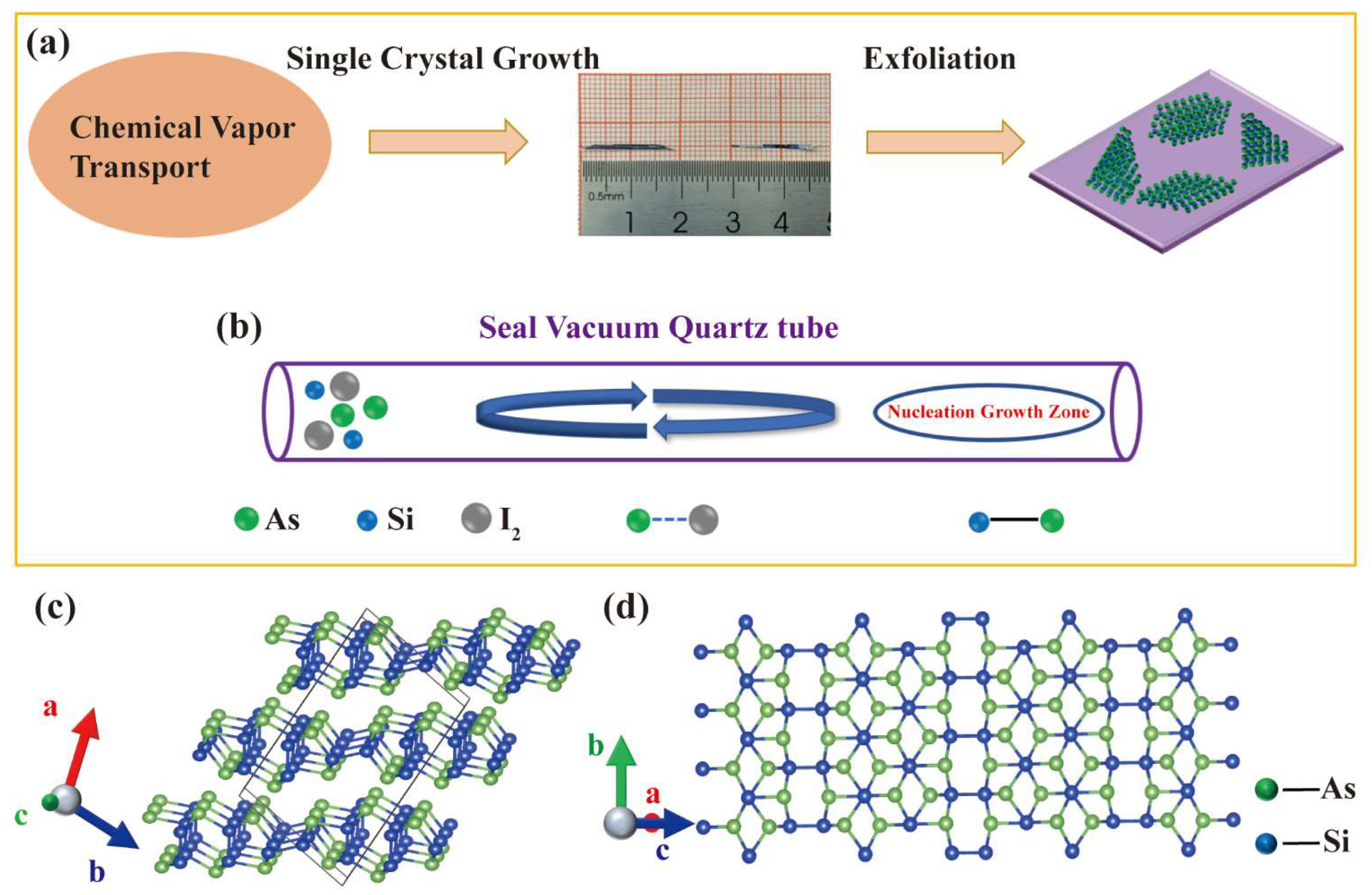
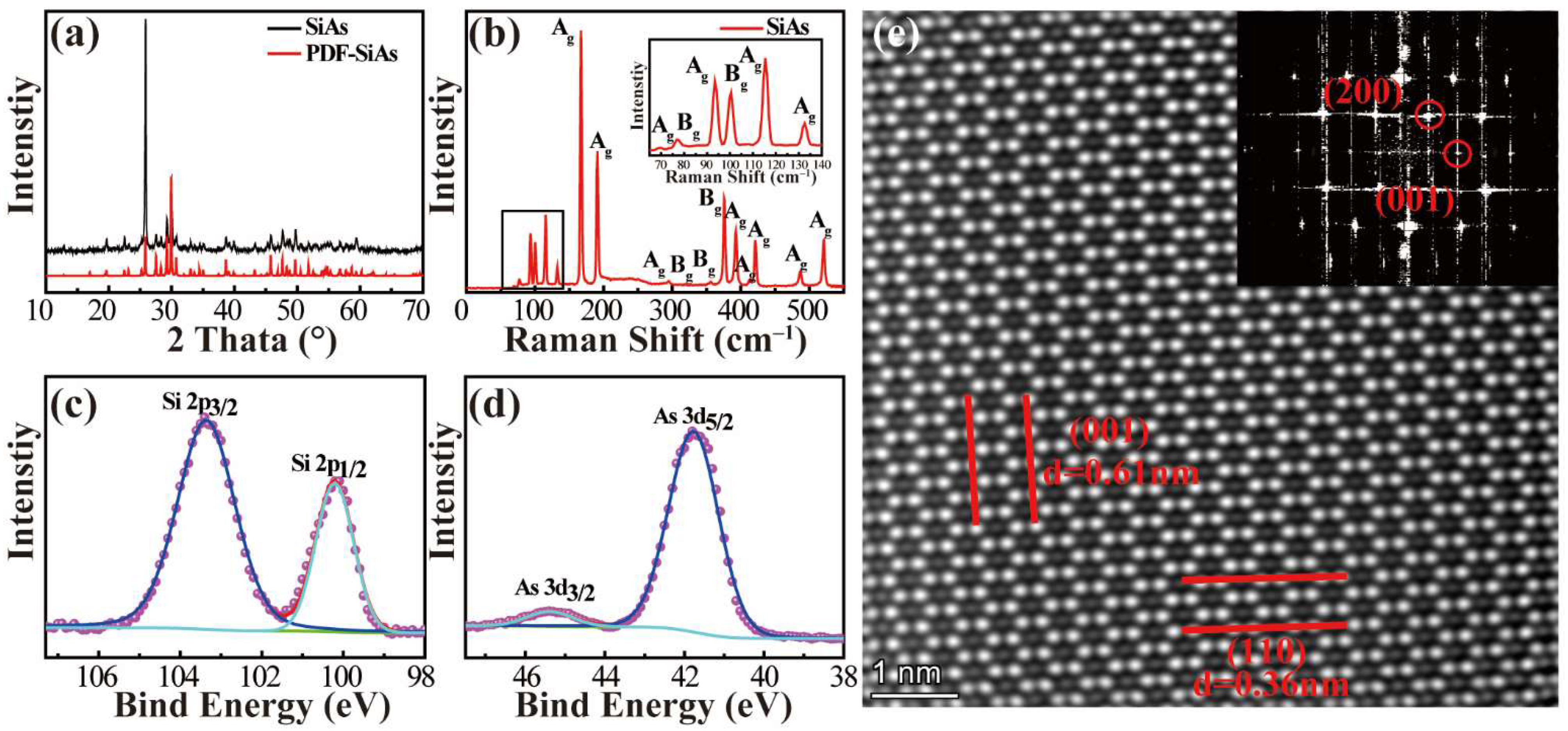

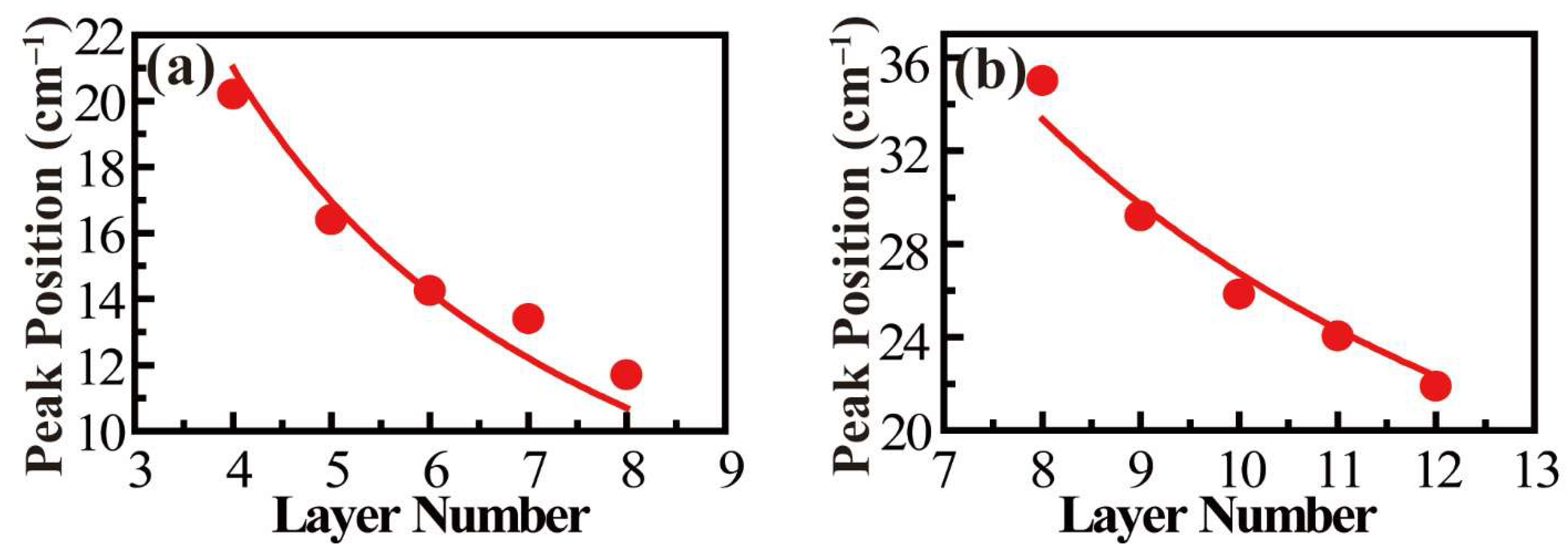
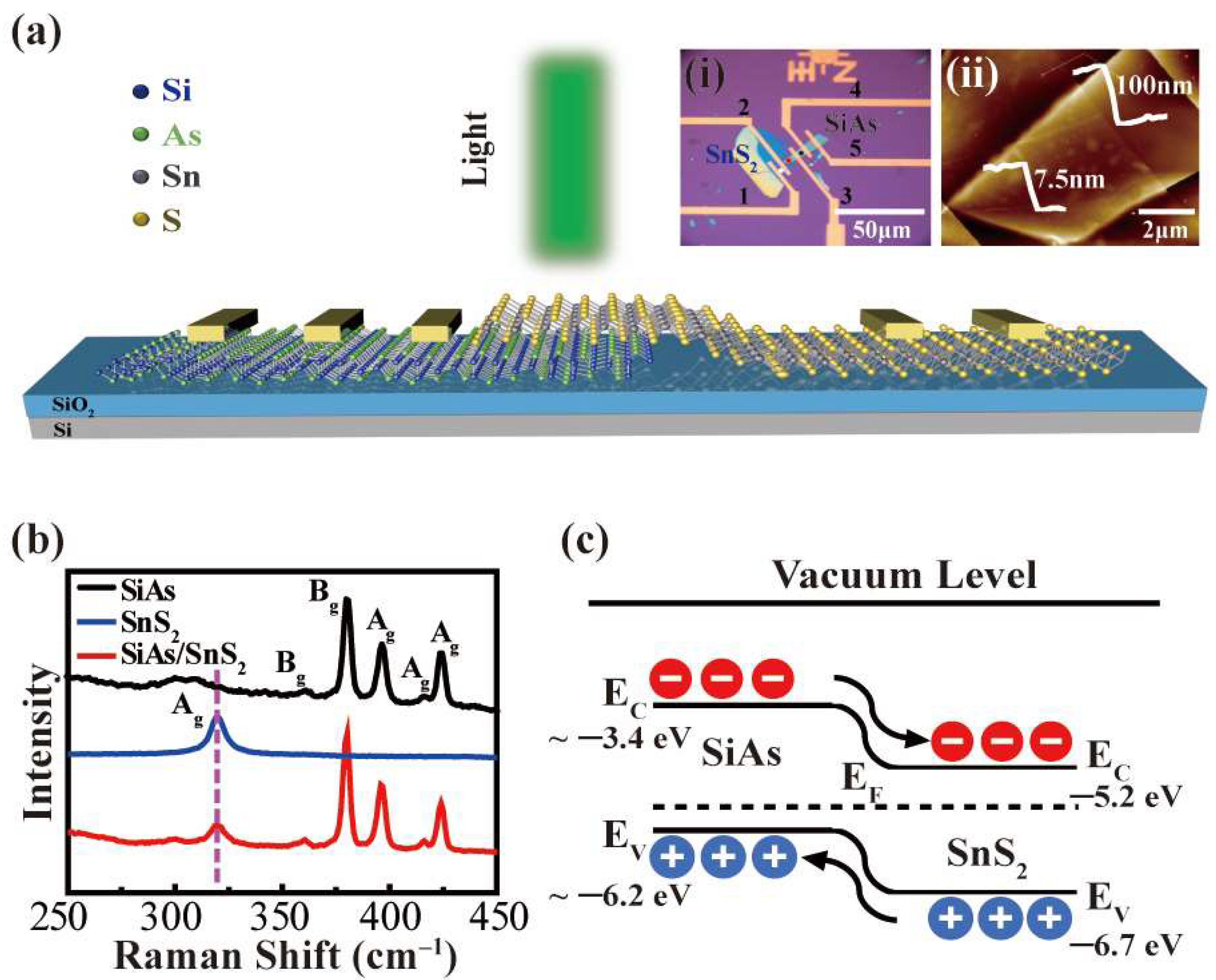

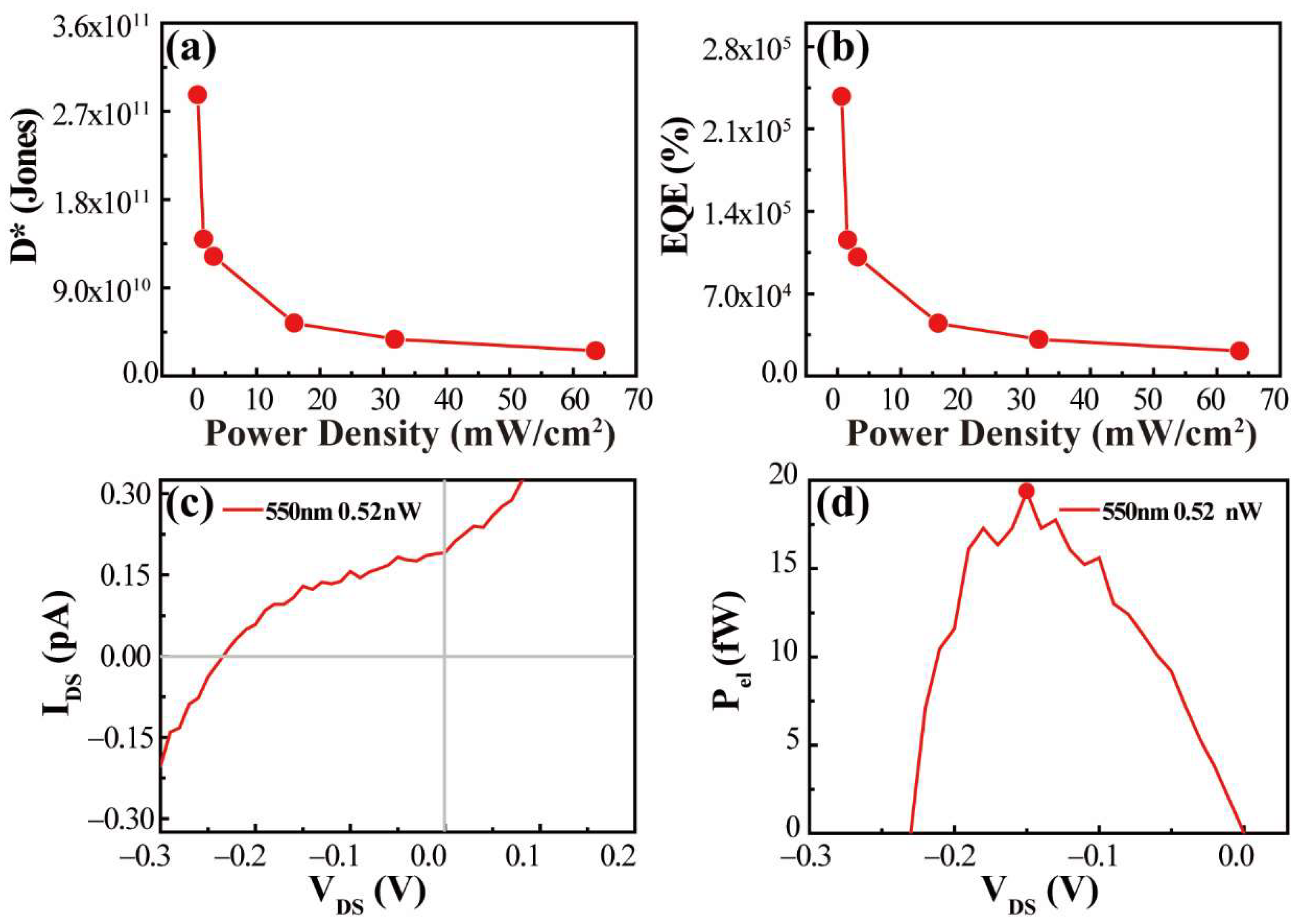
Publisher’s Note: MDPI stays neutral with regard to jurisdictional claims in published maps and institutional affiliations. |
© 2022 by the authors. Licensee MDPI, Basel, Switzerland. This article is an open access article distributed under the terms and conditions of the Creative Commons Attribution (CC BY) license (https://creativecommons.org/licenses/by/4.0/).
Share and Cite
Sun, Y.; Xie, L.; Ma, Z.; Qian, Z.; Liao, J.; Hussain, S.; Liu, H.; Qiu, H.; Wu, J.; Hu, Z. High-Performance Photodetectors Based on the 2D SiAs/SnS2 Heterojunction. Nanomaterials 2022, 12, 371. https://doi.org/10.3390/nano12030371
Sun Y, Xie L, Ma Z, Qian Z, Liao J, Hussain S, Liu H, Qiu H, Wu J, Hu Z. High-Performance Photodetectors Based on the 2D SiAs/SnS2 Heterojunction. Nanomaterials. 2022; 12(3):371. https://doi.org/10.3390/nano12030371
Chicago/Turabian StyleSun, Yinchang, Liming Xie, Zhao Ma, Ziyue Qian, Junyi Liao, Sabir Hussain, Hongjun Liu, Hailong Qiu, Juanxia Wu, and Zhanggui Hu. 2022. "High-Performance Photodetectors Based on the 2D SiAs/SnS2 Heterojunction" Nanomaterials 12, no. 3: 371. https://doi.org/10.3390/nano12030371
APA StyleSun, Y., Xie, L., Ma, Z., Qian, Z., Liao, J., Hussain, S., Liu, H., Qiu, H., Wu, J., & Hu, Z. (2022). High-Performance Photodetectors Based on the 2D SiAs/SnS2 Heterojunction. Nanomaterials, 12(3), 371. https://doi.org/10.3390/nano12030371





